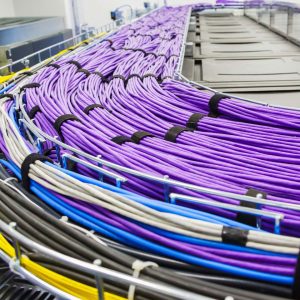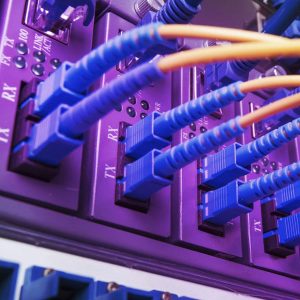Networks beautified
Structured Cabling
General:
The importance of structured cabling.
A structured cabling system is as important to the success of your organization as the people are who work in it.
A well-planned structured cabling system facilitates the continuous flow of information, enables the sharing of resources, promotes smooth operations, accommodates ever-changing technology, offers plenty of room for growth, and evolves with your organization. Plus, it will be around far longer than your current PC, server, and network switches.
In essence, a structured cabling system is the lifeblood of your organization. If done right, it will serve you well for years. If not, your organization’s growth and bottom line can suffer.
The importance of structured cabling has increased right alongside the growth of LANs, MANs, and WANs. It started with individuals working on standalone PCs. It didn’t take long to connect those PCs into workgroups and then to connect those workgroups to a server.
One server became multiple servers. And the rest is history. Today’s networks are complex systems running on technologies that no one could have imagined just 15 years ago.
Spinworks will provide an overview of the standards and practices that govern structured cabling systems. For expert advice on your new or upgraded structured cabling system, and for complete services ranging from design and products through installation and maintenance.
Copper Network (horizontal):
Some of the most obvious advantages copper offers is that it’s less expensive than fiber cable and much easier to terminate in the field. Because copper is the most commonly installed cable, there is a vast selection of connecting hardware and networking devices, which are also less expensive than fiber equipment. Copper cable commonly used for the horizontal cabling system and encompasses everything between the telecommunications room cross-connects to the telecommunications outlets in the work area. It’s called horizontal because the cable typically runs horizontally above the ceiling or below the floor from the telecommunications room, which is usually on the same floor.
Planning horizontal cabling:
 The horizontal cabling system encompasses everything between the telecommunications room cross connects to the outlets in the work area. It’s specified in TIA/EIA-568-B.1 and includes:
The horizontal cabling system encompasses everything between the telecommunications room cross connects to the outlets in the work area. It’s specified in TIA/EIA-568-B.1 and includes:
• Horizontal cabling.
• Telecommunications outlets.
• Telecommunications connectors.
• Cross-connects.
• Patch cords.
Most of the cables in your building will be part of the horizontal cabling system. These can include your voice, data, multimedia, security, HVAC, PoE, wireless, and other systems.
After a building is constructed, the horizontal cabling system is subject to the most activity in terms of users, locations, changes in building layouts, and more. But the horizontal cable is much less accessible than the backbone cable. To change the horizontal cabling after installation can be very expensive, time-consuming, and disruptive. Plan carefully because the horizontal cabling is extremely important to the design and effectiveness of your cabling system.
Fiber Network (Backbone):
Fiber optic technology uses light as an information carrier. The cable consists of a core, a single continuous strand of glass or plastic that’s measured in microns (µ) by the size of its outer diameter. This is the pathway for light rays carrying data signals.
Fiber is the preferred cable for applications that require high bandwidth, long distances, and immunity to electrical interference. It’s the most commonly installed backbone cable as well. The backbone system encompasses all the cabling between telecommunications rooms, equipment rooms, entrance facilities, and between buildings.
Backbone cabling provides the main information conduit connecting all your horizontal cabling within a building and between buildings. It’s the interconnection between telecommunication rooms, equipment rooms, and entrance facilities. In large organizations, you can connect multiple LANs with a high-speed backbone to create large service areas.
Backbone cabling is specified in TIA/EIA-568-B.1 and includes:
- Cabling
- Intermediate and main cross-connects
- Mechanical terminations
- Patch cords or jumpers for backbone to-backbone connections
Another type of backbone is called a collapsed backbone. This is usually a short backbone that has a
central router or switch interconnecting all the LAN segments in a given building.
The main requirement of any backbone is that it will be able to support your current needs as well as
future applications. When planning your backbone, take these factors into consideration.
- Performance and applications: Plan on far more bandwidth than you think you’ll ever need.
- Site size and user population: Current size and future growth requirements must be considered.
- Plan your backbone to accommodate the maximum number of connections anticipated in all telecommunications rooms, equipment rooms, and entrance facilities. You may want to consider installing extra, unused copper or ”dark” fiber cable for future needs.
- Distance: The distance you run your backbone will most likely determine the type(s) of cable you use.
- Redundancy and diverse path routing: Consider diverse path routing for mission-critical systems. This consists of running redundant backbones in separate pathways far from each other. The redundant cables should never be run in the same conduit. Although they terminate at the same place, they will follow different routes to get there, such as on different sides of a building.
- Useful life: Be aware of the minimum length of time the backbone cabling is expected to serve. Replacing backbone cable is inconvenient and expensive.
Network Cable Certification and Labelling:
Once you install your structured cabling infrastructure, you have to test its performance. Just because you bought the best materials and followed all the installation recommendations, it doesn’t mean your system is going to work flawlessly. Transmission performance depends on several factors:
- Cable characteristics
- Connecting hardware
- Patch cords and cross-connect wiring
- Number of connections
- Installation practices
Here in Spinworks, we have the way to do it with Fluke only Cable Analysers.

